Once you get the required tools, select the correct sized adapter for the job, connect the flooring nailer to the air compressor, and set air pressure and you are ready to use the flooring nailer as it should be.
Table of Contents
How To Use a Flooring Nailer
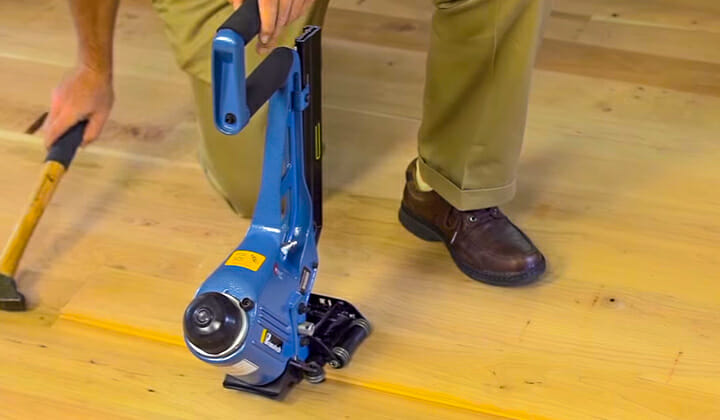
A flooring nailer is an indispensable tool to install hardwood flooring and attach it to the subfloor as it makes the process quick and precise. Even though the first few and last rows of flooring can’t be attached with this tool due to space restrictions, most of the floor can be installed with the nailer at a perfect 45-degree angle.
Notably, a flooring nailer is not an automated or trigger-powered nail gun, it requires a strike with a rubber mallet to set the nail. You’ll need to make some preparations and a bit of time to get the hang of using the nailer. But don’t worry, we got you covered.
The tools that are required for hardwood flooring with a flooring nailer:
- Air compressor
- Nails
- Mallet
- Measuring tape
- Chalk Line
- Drill
- Drill Bit
- Air Hose
- Jig Saw
Correct size adapter selection
First of all, you need to be aware of the thickness of your hardwood. For that, you need a measuring tape to calculate the thickness. According to the square feet of your house, the hardwood floorings are sold. The measurement of the flooring contains a dramatic look on the floor’s final face.
After you are done measuring, use that measuring to select adapter and nails in the floor nailer. Attach the adapter and load the nails of the right size in the nailer magazine.
Connecting the flooring nailer
You can find a lot of quality air compressors in the market. Pick the right size air compressor that you need. Make sure you use the compression fittings on the air hose as you are using an air compressor for hardwood flooring purposes.
Before you continue forward, make sure to connect the air compressor with the floor nailer and it should be tightly secured. A 1.5/2 horsepower electric compressor could be handy in this task.
Setting Air Pressure on the Compressor
In this step, you need to check the manual that comes with the flooring nailer. You can find the correct PSI (Pound Per Square Inch) that is suitable to use with the air compressor. After that, adjust the pressure gauge of the compressor according to the proper PSI settings. This step is finished.
Using the Floor Nailer
Before using the nailer, use a hammer to insert the nails into the first strip of flooring. If you don’t want to go for that hassle you can just directly use a flooring nailer. Place the adapter along the tongue side of the flooring to do this correctly. Then strike the witch or the actuator of the nails with a mallet. It will insert the nail at a 45-degree angle in the flooring.
Now, you may need to use a regular hammer again and finish nails to secure the flooring on the last strip of hardwood flooring. If you keep repeating the process for all the strips of the hardwood correctly like this, you will find no damage to the flooring.
Can You Use a Finish Nailer for Flooring?
If you don’t have a flooring nailer you can use a finish nailer for hardwood flooring. A finish nailer designed for trim work can shoot a near-headless nail that doesn’t mar the surface look of the wood can be used for flooring. This makes a finish nailer effective for flooring as well if you are quite handy with it.
Moreover, a flooring nailer is specially designed for flooring purposes. If you don’t have it, it’s okay. A finish nailer can be used as a second option to a flooring nailer when it comes to flooring.
Staples or Nail Cleats for Hardwood Flooring
Cleats are a specialized kind of nail made for flooring purposes. It has been used for generations by the professional for flooring purposes. It has a unique L shape and its installation requires a mallet.
If you can install it correctly, it will insert smoothly and with a 45-degree angle leaving no gaps between the wood panels. Cleats give your hardwood floors look better and longer and allow for greater movement in areas with high humidity. But it has less availability and is not suitable for DIY tasks.
And it’s not surprising that DIY enthusiasts are very familiar with Staples. These are easy to load, affordable, and have more availability. However, staples are not suitable for harder woods leaving splitting and cracks.
Can You Use 18 Gauge Nails for Flooring?
You can use 18 gauge nails for flooring. But before you do that make sure to use the preferred nails the manufacturer suggested for hardwood flooring. You will also need to measure the thickness of your hardwood. 18 gauge nails are thinner compared to 16 gauge nails.
Honestly, 16 gauge nails being thicker and wider compared to 18 gauge can be used for flooring but could cause tongue splitting problems. On the other hand, 18 gauge will leave no crack and will give your flooring a neat and cleaner finish.
Use of a Flooring Nailer
A flooring nailer is specially made for flooring tasks. It does the quick and clean work of nailing down hardwood flooring tasks. It also helps to insert the nail cleat at a 45-degree angle. The thing is it is not an automatic gun like others, it needs a mallet to set the nail.
To use the flooring nailer place it against the tongue of the board, when its place correctly hit the head of the nail with the rubber mallet. A flooring nailer makes hardwood flooring faster and easier.
Can You Use a Brad Nailer for Flooring?
Brad nailer offers or provides you with a wide range of abilities. If you need to install or replace hardwood floor panels in your home or office you can do it with a brad nailer. It can shoot 18 gauge nails without having to use an old-fashioned hammer.
You can use a brad nailer for flooring purposes. But it depends on the thickness of the wooden flooring plank. If the thickness of the wooden plank is ½” the 18 gauge brad nailer will work fine. But if the thickness of the wooden plank is ¾” or over it, the 18 gauge brad nailer can’t penetrate through that.
Frequently Asked Questions (FAQ)
Should I get a 16 or 18 gauge nailer?
If you want to compare a 16 and 18 gauge nailer, an 18 gauge nailer shoots thinner nails than 16 gauge nails. So, when it comes to heavy-duty works or jobs that require more strength and holding power, a 16 gauge nailer is the better option here. 18 gauge nailers provide you with a neat-clean finish and smoother work.
How do you choose a floor nailer?
It depends on the type of flooring you desire. One thing you need to consider is the thickness of the flooring. After measuring the thickness of the flooring, choose the right tools and as well as the type of wood according to that. Softer woods will require less force compared to harder ones.
To Conclude
If you’re going to use a manual nailer, you may have to use more physical force to make it work correctly. Make sure to wear eye protection when operating a nailer. Consider the process carefully like measuring the thickness of the woods or when buying air compressors. Follow the steps carefully and arrange the architecture of your apartment on your own elegantly.
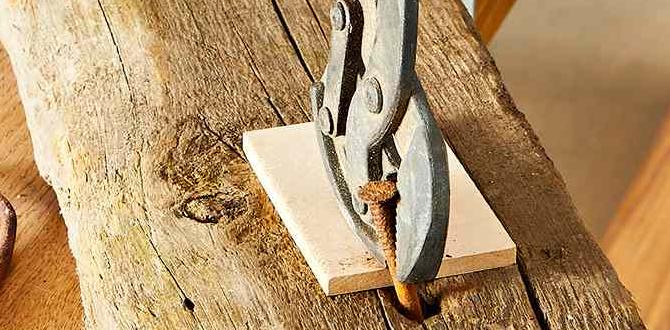


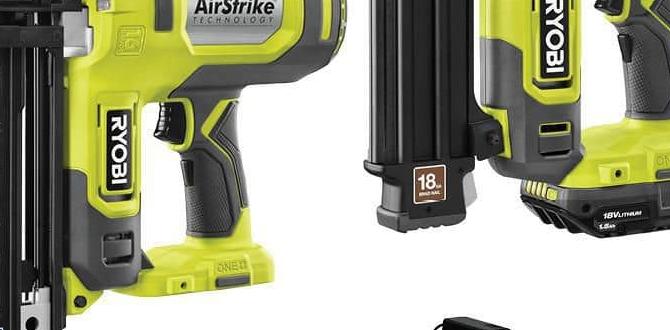
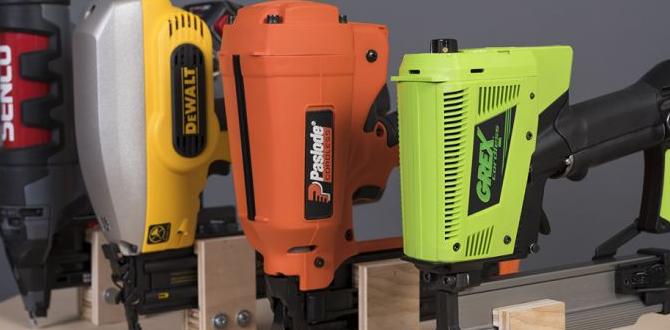
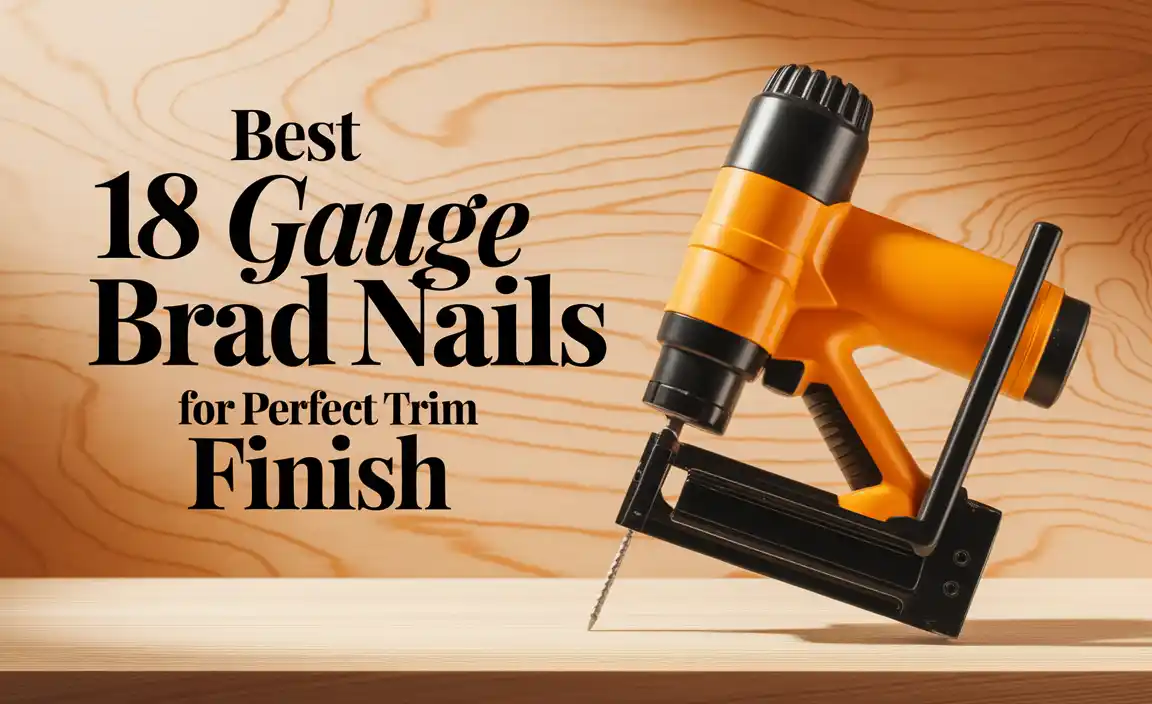
What happens when a cleat inadvertently hits a subfloor screw?